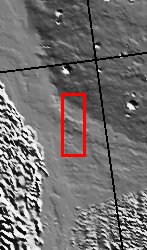
At first glance, this image of lava flows around the large scarp of Olympus Mons shows little contrast in surface materials due to dust cover, but a closer look reveals textures characteristic of the variable surface roughness associated with different lava flows in this region. The lobate edges of the flows are distinctive, and permit the discrimination of many overlapping individual flows. On small scales, the surfaces of some flows look wrinkly and ropy, indicating a relatively fluid type of lava flow referred to as pahoehoe. Other surfaces appear more rough and broken, and might be referred to as a'a flows, which have higher viscosities and effusion rates compared to pahoehoe flows. The surface textures of lava flows can thus sometimes be used for comparative purposes to infer lava viscosity and effusion rates. There is also a bright streak in the wind shadow of the impact crater in the lower left of the image where dust that settles onto the surface is not easily scoured away.
Note: this THEMIS visual image has not been radiometrically nor geometrically calibrated for this preliminary release. An empirical correction has been performed to remove instrumental effects. A linear shift has been applied in the cross-track and down-track direction to approximate spacecraft and planetary motion. Fully calibrated and geometrically projected images will be released through the Planetary Data System in accordance with Project policies at a later time.
NASA's Jet Propulsion Laboratory manages the 2001 Mars Odyssey mission for NASA's Office of Space Science, Washington, D.C. The Thermal Emission Imaging System (THEMIS) was developed by Arizona State University, Tempe, in collaboration with Raytheon Santa Barbara Remote Sensing. The THEMIS investigation is led by Dr. Philip Christensen at Arizona State University. Lockheed Martin Astronautics, Denver, is the prime contractor for the Odyssey project, and developed and built the orbiter. Mission operations are conducted jointly from Lockheed Martin and from JPL, a division of the California Institute of Technology in Pasadena.

